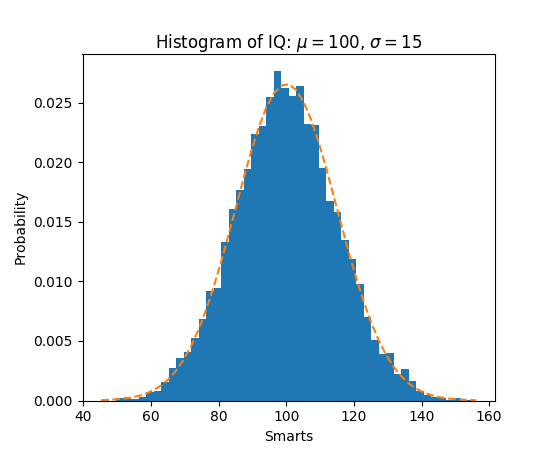| Parameters: | x : (n,) array or sequence of (n,) arrays
Input values, this takes either a single array or a sequency of
arrays which are not required to be of the same length
bins : integer or array_like or ‘auto’, optional
If an integer is given, bins + 1 bin edges are returned,
consistently with numpy.histogram() for numpy version >=
1.3.
Unequally spaced bins are supported if bins is a sequence.
If Numpy 1.11 is installed, may also be 'auto'.
Default is taken from the rcParam hist.bins.
range : tuple or None, optional
The lower and upper range of the bins. Lower and upper outliers
are ignored. If not provided, range is (x.min(), x.max()). Range
has no effect if bins is a sequence.
If bins is a sequence or range is specified, autoscaling
is based on the specified bin range instead of the
range of x.
Default is None
normed : boolean, optional
If True, the first element of the return tuple will
be the counts normalized to form a probability density, i.e.,
n/(len(x)`dbin), i.e., the integral of the histogram will sum
to 1. If stacked is also True, the sum of the histograms is
normalized to 1.
Default is False
weights : (n, ) array_like or None, optional
An array of weights, of the same shape as x. Each value in x
only contributes its associated weight towards the bin count
(instead of 1). If normed is True, the weights are normalized,
so that the integral of the density over the range remains 1.
Default is None
cumulative : boolean, optional
If True, then a histogram is computed where each bin gives the
counts in that bin plus all bins for smaller values. The last bin
gives the total number of datapoints. If normed is also True
then the histogram is normalized such that the last bin equals 1.
If cumulative evaluates to less than 0 (e.g., -1), the direction
of accumulation is reversed. In this case, if normed is also
True, then the histogram is normalized such that the first bin
equals 1.
Default is False
bottom : array_like, scalar, or None
Location of the bottom baseline of each bin. If a scalar,
the base line for each bin is shifted by the same amount.
If an array, each bin is shifted independently and the length
of bottom must match the number of bins. If None, defaults to 0.
Default is None
histtype : {‘bar’, ‘barstacked’, ‘step’, ‘stepfilled’}, optional
The type of histogram to draw.
- ‘bar’ is a traditional bar-type histogram. If multiple data
are given the bars are aranged side by side.
- ‘barstacked’ is a bar-type histogram where multiple
data are stacked on top of each other.
- ‘step’ generates a lineplot that is by default
unfilled.
- ‘stepfilled’ generates a lineplot that is by default
filled.
Default is ‘bar’
align : {‘left’, ‘mid’, ‘right’}, optional
Controls how the histogram is plotted.
- ‘left’: bars are centered on the left bin edges.
- ‘mid’: bars are centered between the bin edges.
- ‘right’: bars are centered on the right bin edges.
Default is ‘mid’
orientation : {‘horizontal’, ‘vertical’}, optional
If ‘horizontal’, barh will be used for
bar-type histograms and the bottom kwarg will be the left edges.
rwidth : scalar or None, optional
The relative width of the bars as a fraction of the bin width. If
None, automatically compute the width.
Ignored if histtype is ‘step’ or ‘stepfilled’.
Default is None
log : boolean, optional
If True, the histogram axis will be set to a log scale. If log
is True and x is a 1D array, empty bins will be filtered out
and only the non-empty (n, bins, patches) will be returned.
Default is False
color : color or array_like of colors or None, optional
Color spec or sequence of color specs, one per dataset. Default
(None) uses the standard line color sequence.
Default is None
label : string or None, optional
String, or sequence of strings to match multiple datasets. Bar
charts yield multiple patches per dataset, but only the first gets
the label, so that the legend command will work as expected.
default is None
stacked : boolean, optional
If True, multiple data are stacked on top of each other If
False multiple data are aranged side by side if histtype is
‘bar’ or on top of each other if histtype is ‘step’
Default is False
|
|---|

